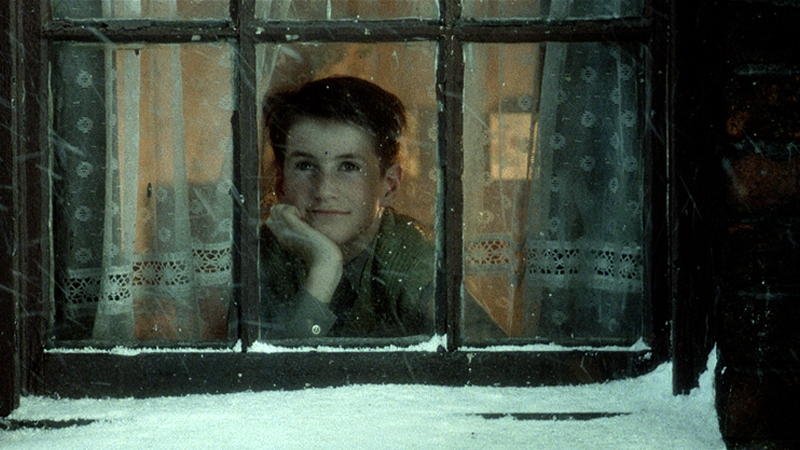The following is excerpted from the book-length study ###terence davies, out September 8. See the bottom of the post for a clip of the scene it describes.
Excerpt copyright 2014 by the Board of Trustees of the University of Illinois and University of Illinois Press.
Terence Davies crafts images that are beholden only to his own artistic sensibility and are unique in narrative cinema for their compositional daring. “I’ve no idea where my style comes from. I’ve not studied painting, I’ve not studied sculpture, it’s all just visual intuition,” he once said. One of the most talked-about shots in all of Davies’s films is a galvanizing image about two-thirds of the way into The Long Day Closes. In Davies’s published script, it is inconspicuous: the simple sentence “Hold on floor” in no way augurs the impact of the scene as it appears on-screen. As eagerly remarked upon by detractors as well as fanatics, this image is used as an example of both the impressionistic lengths to which he will go and the limits the narrative cinematic form can handle. It was even a primal moment for Gillian Anderson’s relationship with Davies—before she was courted to star in The House of Mirth, she claimed to have been emotionally stricken by it inThe Long Day Closes: “I remember sitting in the theater and bursting into tears. There was just something about it that was so rich and so full and said so much, even though it was centered on a rug. I was just blown away by it,” she told the Guardian. The responses of many audience members were quite different, according to Davies on the audio commentary track for the BFI DVD edition of the film, who says that the shot “caused a lot of controversy. I cannot tell you how apoplectic with anger some people get!” Since it is an immaculate synthesis of all the concerns I have raised as quintessentially Daviesian (music, lighting, color, composition, perspective) as well as an example of the implicitly and unusually confrontational nature of his art, I will dwell upon this image for the remainder of this section—appropriate, since Davies’s camera dwells upon it for an inordinate amount of time.
The sequence directly follows Bud’s terrible nightmare of two male hands reaching out to grab him from the shadows of his dark bedroom.
The sequence directly follows Bud’s terrible nightmare of two male hands reaching out to grab him from the shadows of his dark bedroom. Held in his mother’s comforting arms after she has rushed to console him, David glances down to the floor, and the camera tracks his gaze, settling on a rug patterned with crosshatched green leaves. The moonlight shining through the rain-spattered window casts cascading shadows on it, giving its expressive design the feel of a living nighttime jungle. Yet Davies doesn’t allow the viewer much time to contemplate this pattern, as the screen dissolves to a different carpet, this one knit with irregular shapes, including elongated diamonds, squiggly lines, color patches, and circles; the camera is positioned in such a way that all of these configurations drape vertically down the frame. At first the carpet is covered by what appears to be afternoon shadow, which gives it a colorless uniformity, but then very gradually sunlight begins to dance over its textures, revealing its beiges, whites, grays, and dull oranges.

The sun moves back and forth on the rug as though a glissando across a piano. The camera remains fixed while this play of light occurs, its static positioning made all the more acute by the natural movement of the sunlight. After one full minute of stillness—a cinematic eternity—while the sun seems to peek in and out of clouds, casting alternating patches of shadow and light, the camera unexpectedly begins to slowly pivot to the right, while remaining fixed on the same spot, until finally it tilts up and we see Bud from the back, kneeling on the couch and staring out the window in his usual spot, the curtain draped over him like a veil, the light from outside giving him the sense of glowing from within.
Davies has said that this sequence was, like so many others, based on his memories. In this case, he recalls the occasional boredom of childhood, when he would find himself at home, fixating on small details, such as a rug’s pattern. What is particularly fascinating about what the camera reveals when it finally tilts up is that we are not seeing this rug directly through the eyes of Bud, whose gaze is instead directed outside. Since Davies’s authorial perspective is so utterly connected to Bud’s point of view, we can assume that he, too, is already glancing elsewhere. Rather, the gaze here appears intended to be the viewer’s alone, dissociated momentarily from Bud and from the narrative. Davies seems to want us to see the world anew; to defamiliarize the familiar; to find the loveliness in the odd patterns of a shabby, tattered carpet; to appreciate the beauty of a natural dance of sunlight; to experience boredom, to crave movement, to both fear and embrace stasis; to just look, and to be.
By drawing our eyes to the pattern on the rug so completely, disallowing us from looking anywhere else in the room for an extended period of time, Davies pointedly frames this unremarkable carpet as a self-contained work of art in its own right. Indeed, the pattern, which offers no symmetry or coherent structure (its lines and waves are unsettlingly inconsistent), might strike some as a painterly piece of lyrical abstraction, its coldness put into relief by the sunlight cast upon it. We are forced to consider its shapes as though we have been drawn to them in a museum. The rug acts as a passive, found art object and an active signal to Davies’s memories; either way, it is spectacular in its inescapable mundaneness.
Inseparable from the visual splendor of the image is the accompanying music on the soundtrack. While filming this scene, Davies played on set the piece that would be used in the final cut, so that he could appropriately time every camera rest and movement. The rhapsodic orchestral passage Davies takes from the British composer George Butterworth’s “A Shropshire Lad” (1911–12) is splendidly bucolic, instantly adding a naturalism and gravitas to a challenging and modernist cinematic move. Through the music, the scene becomes an unexpected idyll. When the camera is immobile, fixed on the carpet as the light comes in, the music is transporting—a glistening harp conjures images of sun-dappled fields and waving grasses. As the camera begins to rotate, however, violins grow more insistent, and the piece takes on a boldly dramatic, even romantic turn. Timed in this fashion, the music quite blatantly calls attention to the attendant camera work, almost as though it is instructing the audience to pay attention to the slightest alteration in the image, as perhaps therein lie the secrets to understanding what Davies is doing.
In this way, the scene reveals the inherent self-referentiality of Davies’s films. Rather than adhere to the strict naturalism endemic to most memory or autobiographical films, Davies makes the audience aware of the cinematic apparatus that creates these necessarily artificial images. This is indicative of the hyperrealism Davies claims he sought to achieve in The Long Day Closes. In Film Comment, Graham Fuller called him “the acknowledged master of tableau that, framed and arranged with adroit self-consciousness, memorializes a fragment in time as it passes, or as it is perceived.” There’s no doubt that the rug is a deliberate provocation. In a way, the film’s insistent focus on this object is a queering agent, not only for how it implies an identification with a marginalized child on the verge of homosexual puberty but also for the way it forces a close reading—a luxurious lavishing of attention—on an object that another film might consider visual debris. As Elizabeth Freeman writes in Time Binds: Queer Temporalities, Queer Histories, “To pause on a given image, to repeat an image over and over, or to double an existing film in a remake or reshoot become productively queer ways to ‘desocialize’ that gaze and intervene on the historical condition of seeing itself.” The amount of time that is expended upon our watching and scrutinizing the rug challenges our presumptions about mainstream film grammar. As I’ll examine later in this book, Davies’s aesthetic is bound up in a queer temporality—which in the carpet’s case manifests as a stillness that threatens to place this film outside of traditional notions of time. It is an image that, however unadorned, intends to alter the viewer’s perceptions, upending expectations of what cinema can be—and perhaps more importantly, implying that the often contradictory nature of beauty lies in the (camera) eye of the beholder.
✪
![[Futuristika!]](https://futuristika.org/wp-content/uploads/2020/12/futuristika-scaled.png)

